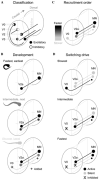Some principles of organization of spinal neurons underlying locomotion in zebrafish and their implications
- PMID: 20536924
- PMCID: PMC3579554
- DOI: 10.1111/j.1749-6632.2010.05539.x
Some principles of organization of spinal neurons underlying locomotion in zebrafish and their implications
Abstract
Recent studies of the spinal motor system of zebrafish, along with work in other species, are leading to some principles that appear to underlie the organization and recruitment of motor networks in cord: (1) broad neuronal classes defined by a set of transcription factors, key morphological features, and transmitter phenotypes arise in an orderly way from different dorso-ventral zones in spinal cord; (2) motor behaviors and both motoneurons and interneurons differentiate in order from gross, often faster, movements and the neurons driving them to progressively slower movements and their underlying neurons; (3) recruitment order of motoneurons and interneurons is based upon time of differentiation; (4) different locomotor speeds involve some shifts in the set of active interneurons. Here we review these principles and some of their implications for other parts of the brain, other vertebrates, and limbed locomotion.
Conflict of interest statement
Figures

References
MeSH terms
Grants and funding
LinkOut - more resources
Full Text Sources

